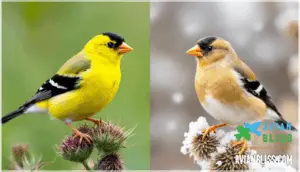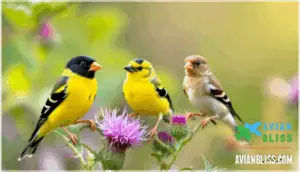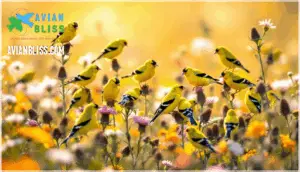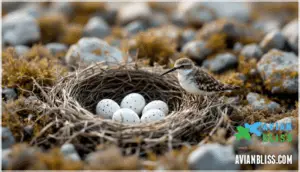This site is supported by our readers. We may earn a commission, at no cost to you, if you purchase through links.

These small finches pull off one of nature’s most dramatic makeovers twice a year, swapping between vivid breeding colors and camouflage winter tones. They’re strict vegetarians that time their nesting to the ripening of thistle seeds, defying the spring breeding schedule most songbirds follow.
Their undulating flight pattern and cheerful calls make them unmistakable once you know what to watch for.
Table Of Contents
- Key Takeaways
- Identifying The American Goldfinch
- American Goldfinch Habitat and Range
- Goldfinch Behavior and Social Patterns
- American Goldfinch Diet and Feeding
- Breeding and Nesting Habits
- Frequently Asked Questions (FAQs)
- Is it rare to see an American Goldfinch?
- What does it mean when you see an American Goldfinch?
- Are American Goldfinches friendly?
- Where do American Goldfinches nest?
- Is the American goldfinch affected by climate change?
- What are the main threats faced by goldfinches?
- How do human activities impact goldfinch populations?
- Are American goldfinches affected by pesticides?
- What makes American goldfinches a common sight?
- How do American Goldfinches interact with other bird species?
- Conclusion
Key Takeaways
- American Goldfinches undergo a dramatic seasonal molt twice yearly, transforming from bright lemon-yellow breeding plumage to drab olive-brown winter feathers—a change driven by carotenoid pigments and testosterone that helps them attract mates in summer and stay camouflaged when food is scarce in winter.
- Unlike most songbirds that breed in spring, goldfinches delay nesting until July through early September to sync with ripening thistle and milkweed seeds, which they feed exclusively to their chicks and use as waterproof nest lining.
- These strict vegetarians consume over 90% of their diet from composite plant seeds like thistle, sunflower, and aster, eating roughly 30% of their body weight daily through specialized conical bills and acrobatic feeding skills that let them hang upside-down on seed heads.
- With a stable population of 42-47 million birds across North America, goldfinches thrive in weedy fields, meadows, and suburban yards where native seed-bearing plants grow, though they face threats from habitat loss, pesticide exposure, and climate change shifting their breeding ranges.
Identifying The American Goldfinch
You can spot an American Goldfinch by its size, color, and bill shape. Males transform from drab winter plumage to vibrant yellow each breeding season.
Here’s what to look for when identifying these small finches in the field.
Physical Characteristics and Plumage
You’ll recognize an American goldfinch by its compact size and vibrant feather colors. Adults measure 11–14 cm in length with a wingspan around 19–22 cm. Their bright yellow plumage comes from dietary carotenoids, while melanin creates the striking black wing and tail feathers. The male American Goldfinch sports a bright lemon-yellow body during breeding season.
Key identification markers include:
- Conical bill measuring 0.9–1.1 cm, perfectly shaped for seed extraction
- Black wings with distinctive dual white bars visible in flight
- Short, notched tail with white patches
- Weight range of 11–20 grams, about half an ounce
- Sexual dimorphism evident in breeding males’ lemon-yellow body and black cap
Seasonal Changes in Appearance
The American Goldfinch undergoes dramatic transformations twice each year through distinct molting cycles. Males shift from vivid lemon-yellow breeding plumage to drab olive-brown winter feathers. This color change relies on carotenoid pigments and testosterone-driven processes. Sexual dichromatism is most pronounced in summer when males display black caps, while females remain duller year-round.
| Season | Male Plumage | Female Plumage | Bill Color | Adaptive Functions |
|---|---|---|---|---|
| Summer (Breeding) | Bright yellow body, black cap and wings | Dull yellow-olive, no black cap | Bright orange | Mate attraction, health signaling |
| Winter (Non-breeding) | Brown-olive body, no cap | Similar brown-olive tone | Grayish-brown | Camouflage, energy conservation |
The complete post-nuptial molt occurs from August through October, replacing all feathers over six to eight weeks. In spring, a partial molt affects only body feathers, not flight feathers. These plumage variations serve adaptive functions: darker winter colors provide camouflage in bare landscapes and reduce pigment production costs when food is scarce.
During this time, their legs and feet also undergo noticeable physical changes. Non-feather changes accompany molting, including the bill shifting from orange in summer to grayish-brown in winter, synchronized with hormonal cycles and dietary shifts.
Distinguishing Males, Females, and Juveniles
You’ll notice plumage dimorphism most clearly during breeding season when males sport black caps and bright yellow bodies while females stay olive-yellow without the cap. Juvenile American Goldfinch identification proves trickier since young birds resemble females with brownish tones and less defined wing patterns.
Bill coloration offers another clue—breeding males show vibrant orange bills while females display paler tones. Wing patterns and tail markings help separate sexes, though ID reliability drops noticeably outside breeding season when up to 17% of birds show ambiguous features.
Key Differences From Similar Species
Beyond sex and age, you’ll want to separate American Goldfinches from look-alikes like Lesser Goldfinch and Lawrence’s Goldfinch. Similar goldfinch species show key differences in plumage comparison and bill morphology that simplify American Goldfinch identification.
Quick ID tips for identifying American Goldfinches:
- Wing bars: You’ll see two crisp white bars on American Goldfinches, while Lesser Goldfinch shows one faint bar and Pine Siskins display streaked brown wings
- Bill shape: American Goldfinches have thicker, conical orange bills compared to the delicate gray bills of Lesser Goldfinch
- Size variations: At 4.3–5.1 inches, American Goldfinches outsize Lesser Goldfinch (3.5–4.3 inches) but measure smaller than Evening Grosbeaks (6.3–8.3 inches)
Habitat overlap occurs in western regions where behavior contrasts help—American Goldfinches prefer open weedy fields while Lesser Goldfinches favor shrubby areas.
American Goldfinch Habitat and Range
American Goldfinches don’t just show up anywhere. They seek out specific environments with the right mix of open space and vegetation.
Understanding where these birds live and how they move across North America will help you spot them in your area.
Preferred Environments and Vegetation
You’ll find goldfinches where open fields meet scattered shrubs and trees—a mix of meadows, grasslands, and weedy patches that burst with seed-bearing plants. They favor composite flowers like thistle, sunflower, and aster, which provide both nesting materials and food. Agricultural edges and suburban yards with native herbaceous vegetation have become prime American Goldfinch habitat, especially when shrubs offer protected nesting structures.
| Habitat Type | Key Vegetation | Goldfinch Use |
|---|---|---|
| Open fields & meadows | Thistle, aster, goldenrod | Primary foraging zones |
| Semi-open woodlands | Deciduous shrubs, saplings | Nesting sites (0.9–7.6 m high) |
| Riparian areas | Milkweed, cattail, sunflower | Seed source & nest materials |
| Suburban yards | Native composites, shrubs | Year-round feeding & breeding |
| Agricultural margins | Early-successional weeds | Seasonal variation support |
Human influence has expanded suitable habitat through land clearing and bird feeders, supporting populations exceeding 43 million across North America.
Geographic Distribution Across North America
From coast to coast, you’ll encounter American Goldfinches across a geographic distribution spanning North America from Saskatchewan to Mexico. Breeding densities peak in the Great Lakes states and North Dakota, where you’ll find up to 14 nests per hectare.
Year-round populations inhabit the Midwest, Pacific Northwest, and eastern United States, while range shifts northward reflect warming trends and habitat variations across regional residency zones.
Seasonal Movements and Migration Patterns
Unlike strictly seasonal migrants, American Goldfinch migration patterns respond primarily to seed availability rather than temperature alone. You’ll observe peak movements during mid-fall and early spring as flocks shift between breeding zones in southern Canada and wintering grounds across the southern United States.
Regional variability defines their behavior—northern populations migrate more reliably, while Mid-Atlantic birds often remain year-round when feeders provide consistent food sources, demonstrating facultative migration influenced by environmental conditions.
Goldfinch Behavior and Social Patterns
American Goldfinches don’t just show up randomly—they move, feed, and interact in patterns you can predict once you know what to look for.
These birds are highly social and spend much of their year in flocks. You’ll notice three main patterns that shape how they live and survive.
Flocking and Foraging Habits
You’ll notice American Goldfinch behavior and flocking changes dramatically outside the breeding season. These birds gather in flocks ranging from 20 to several hundred individuals, traveling together in search of seed-rich habitats. Their foraging behavior is highly efficient, with individuals consuming about 1.2 grams of seed per hour.
Key aspects of goldfinch flocking and foraging behavior:
- Flock size varies seasonally – Groups average 20-50 birds in fields during autumn and winter, breaking into pairs by late spring.
- Foraging habitats span 5 miles daily – They move between weedy fields, roadsides, and feeders searching for composite seeds like thistle and asters.
- Feeding efficiency peaks through acrobatics – You’ll see them hanging upside down on seed heads, accessing food other birds can’t reach.
- Winter foraging shifts to feeders – During harsh conditions, 30-50% of their diet comes from backyard nyjer and sunflower offerings.
Their seed preferences and foraging habitats adapt as resources change throughout the year.
Flight Patterns and Vocalizations
You’ll recognize an American Goldfinch in flight by its distinctive bouncy, wave-like pattern. The bird flaps its wings two to five times, then tucks them in and glides downward before repeating the cycle. This undulating flight conserves energy while moving between foraging sites. Each time the goldfinch dips and rises, it calls out "po-ta-to-chip" or "per-chick-o-ree"—synchronized calls that help flocks of 10 to 40 birds stay coordinated.
| Flight Feature | Function |
|---|---|
| Undulating pattern | Energy conservation and maneuverability |
| Synchronized calls (3-8 kHz) | Flock coordination and spacing |
| Lower flight in wind | Adaptation to environmental conditions |
These vocalizations serve multiple purposes beyond simple communication. The calls alert nearby birds to threats and reinforce pair bonds during migration. Urban goldfinches even shorten their call sequences to navigate obstacles more quickly.
Adaptations for Seed Eating
The American Goldfinch’s conical bill morphology acts like a precision tool, cracking seeds with striking speed and efficiency. This bill structure is paired with a muscular gizzard that grinds hard seeds without teeth. Their diet specialization—99% seeds—drives unique foraging agility.
Goldfinches cling upside-down to thistle heads, using acrobatic skills that most seed eaters can’t match. This dietary habit shapes their entire digestive system, from bills and beaks designed for husking to specialized seed digestion. Even their young are fed regurgitated seeds instead of insects.
American Goldfinch Diet and Feeding
American Goldfinches are strict vegetarians with a taste for seeds above all else. You’ll find them munching on thistle, sunflower, aster, and similar plants throughout the year.
Their diet shifts with the seasons and what’s available, making them reliable visitors at backyard feeders stocked with the right offerings.
Primary Food Sources and Preferences
When you think seed eaters, goldfinches are true specialists. Their American Goldfinch Diet revolves almost entirely around seeds, with over 90% coming from composite plants like thistles, dandelions, and sunflowers. These Preferred Seed Types deliver the high-fat fuel goldfinches need year-round.
Key nutritional highlights include:
- Oil-rich seeds: Thistle seeds contain over 35% lipid content, essential for energy and thermoregulation
- Daily intake: Goldfinches consume roughly 30% of their body weight each day to meet metabolic demands
- Seasonal Diet Shifts: Tree seeds from alder and birch become significant when herbaceous plants are dormant in winter
Their Feeding Adaptations—conical beaks designed for shelling—make seed extraction efficient. You’ll notice goldfinches balance expertly on swaying stems, plucking seeds with precision. This selective feeding saves time and aids their role in Seed Dispersal across meadows and weedy fields.
Feeding Behavior at Feeders and in The Wild
Knowing their seed preferences is one thing, but watching how goldfinches actually feed reveals their true skill. You’ll find American Goldfinch diet behavior splits between backyard feeders and wild foraging zones, each showcasing different feeding behavior strategies.
Feeder Adaptability shines through their use of tube, mesh, hopper, and platform feeders. They’re comfortable hanging upside down or perching upright—whatever gets them to those seeds. Nyjer and sunflower hearts dominate their seed preferences because both offer easy access and high energy. Studies show up to 30 birds may gather at feeders during winter, though goldfinches often yield to more aggressive species like Pine Siskins.
| Location | Feeding Strategy |
|---|---|
| Backyard feeders | Perching upright or inverted on tubes and mesh |
| Wild seed heads | Balancing on thin stems, extracting seeds acrobatically |
| Ground | Opportunistic scavenging of spilled or fallen seeds |
| Tree branches | Harvesting alder, birch seeds, sap, and buds |
| Flock movements | Traveling 4–5 miles daily between feeding sites |
In wild foraging settings, you’ll spot them clinging to swaying thistle and coneflower heads, using rapid beak movements to crack open pods. Social dynamics matter here—flocks coordinate feeding across miles of open habitat, using calls to stay connected. Seasonal patterns drive this: feeder visits peak in late fall and winter when wild seeds decline, while summer activity shifts back to blooming composite plants.
Seasonal Variations in Diet
Goldfinches shift their American Goldfinch Diet with the seasons, driven by what’s blooming and what seeds remain accessible. Their feeding behavior adapts as migration triggers and breeding nutrition needs change throughout the year.
Seasonal diet breakdown:
- Winter Seed: Black-oil sunflower and nyjer dominate, offering fat content near 50% for cold-weather energy
- Summer Forage: Wild thistle, aster, and coneflower seeds fuel breeding, with consumption rising 20–25% during nesting
- Spring and Fall: Dandelions and goldenrod provide interim nutrition, supporting short-distance migration up to 200 miles
Preferred plants mirror seed availability—goldfinches time nesting to late-blooming composite flora, ensuring chicks receive high-protein seeds when other birds rely on insects.
Breeding and Nesting Habits
American Goldfinches don’t rush into parenthood like other songbirds. They wait until mid-summer to start nesting, when thistles and other seed plants are going strong.
This late timing connects directly to how they build their nests, where they raise their young, and how long they live in the wild.
Nest Construction and Materials
You’ll notice the female builds her nest like an architect, working in three stages. First, she forms an outer cup from twigs and binds them with spider silk. Next comes a dense middle layer of rootlets and plant fibers for structural integrity. Finally, she lines it with thistle or milkweed down, creating a material waterproof quality so tight it can hold water.
Female goldfinches architect waterproof nests in three stages, weaving twigs with spider silk, layering plant fibers, and lining with thistle down so dense it holds water
This nest site selection and weaving process takes about six days, resulting in nesting behavior perfectly timed with seed availability for American Goldfinch nesting success.
Timing and Location of Nesting
Unlike most North American songbirds, American Goldfinch nesting begins between July and early September, with peak activity in late July through August. This delayed breeding season aligns with environmental cues like ripening thistle and milkweed seeds. You’ll find nests positioned 3 to 25 feet high in shrubs or small deciduous trees near meadows and floodplains.
Regional variations exist—western populations often start nesting in late June, while New England birds peak in August, demonstrating habitat selection tied to local seed availability.
Egg Laying, Incubation, and Chick Care
Once breeding begins, you’ll observe clutch sizes of four to six eggs, pale bluish-white with occasional faint brown spots. The female undertakes incubation alone for twelve to fourteen days while the male brings her regurgitated seeds.
Hatchlings emerge naked and helpless, fed exclusively seeds by both parents. Nestling development progresses rapidly over eleven to seventeen days.
As chicks mature, males assume primary feeding duties while females may start a second brood. Parental care continues two to three weeks post-fledging, ensuring brood success through late summer.
Lifespan and Conservation Status
In the wild, you’ll find American goldfinches living three to six years on average, though banded individuals have reached eleven years. Males generally outlive females due to reduced nest predation exposure.
First-year mortality ranges from 60% to 70%, driven by predation, severe weather, and diseases like salmonella.
The IUCN lists this species as Least Concern, with populations of 42 to 47 million birds showing stable trends despite minor regional declines since 1966.
Frequently Asked Questions (FAQs)
Is it rare to see an American Goldfinch?
You won’t find these goldfinches too scarce—they’re actually golden opportunities in most backyards. With roughly 74 million American Goldfinch individuals across North America, population stability remains strong.
Regional abundance varies, but habitat impact in weedy fields and urban sightings at feeders make them accessible. Migration brings flocks seasonally, and their conservation status as Least Concern confirms they’re far from rare.
What does it mean when you see an American Goldfinch?
Spotting an American Goldfinch doesn’t carry a specific omen or spiritual significance in scientific terms. You’re simply witnessing a common North American bird visiting your habitat for food sources like seeds, especially if feeders or weedy fields are nearby.
Are American Goldfinches friendly?
American Goldfinches show high tolerance toward humans and share feeders peacefully with other birds.
However, males become territorial during breeding season, chasing rivals and displaying vocal aggression to defend mates and feeding areas.
Where do American Goldfinches nest?
You’ll find them building nests 4 to 20 feet up in shrubs and small trees, especially native plants like thistles, milkweed, and coneflowers.
Nesting behavior centers on sites near water, where structural integrity comes from plant fibers woven with spider silk—sometimes waterproof enough to hold liquid.
Is the American goldfinch affected by climate change?
Yes, climate change affects goldfinches considerably. Migration shifts occur with spring arrivals now 15-18 days earlier. Breeding success drops during hot, dry periods. Food availability mismatches happen when seed production timing changes. Habitat changes include range contractions and northward shifts. These ecological mismatches threaten their conservation status.
What are the main threats faced by goldfinches?
Goldfinches face multiple threats, including habitat loss from development, pesticide exposure that harms reproduction, and avian diseases like trichomoniasis.
Additionally, they are vulnerable to predation risks from cats and window collisions, as well as climate threats that shift breeding ranges.
Conservation efforts focus on protecting weedy fields and reducing chemical use.
How do human activities impact goldfinch populations?
Human activities create serious challenges for goldfinch populations. Habitat destruction has reduced their range by up to 27% since Urbanization fragments habitats and decreases reproductive success.
Pesticides like imidacloprid have killed goldfinches directly and reduced insect food sources. Climate change threatens two-thirds of their breeding range with rising temperatures.
Conservation efforts focus on preserving weedy fields and reducing pesticide use.
Are American goldfinches affected by pesticides?
Like a canary in a coal mine, seed-eating birds signal environmental trouble. Yes, American goldfinches face serious risks from pesticides, especially neonicotinoids coating seeds.
Seed contamination leads to acute poisoning, reproductive effects, and population decline. Their granivorous diet makes them vulnerable since treated seeds concentrate toxins.
Conservation strategies include reducing pesticide use near their habitat, protecting insects they occasionally eat, and monitoring their conservation status as indicators of ecosystem health.
What makes American goldfinches a common sight?
Their adaptability factors shine through habitat diversity—thriving in weedy fields, suburbs, and backyard bird feeders.
Diet flexibility with seeds, a stable population of 43 million, and social foraging in large flocks make them abundant across the diverse American Goldfinch habitat and range.
How do American Goldfinches interact with other bird species?
How do birds coexist when resources run tight? American Goldfinch flock behavior shows peaceful seed dispersal alongside Pine Siskins and Redpolls during foraging.
At feeders, mild aggression surfaces as they displace smaller bird species, yet they respond to alarm calls from chickadees and nuthatches, forming cooperative networks against bird predators despite nesting competition.
Conclusion
Like watching a sunrise paint the sky gold, spotting an American goldfinch transforms an ordinary moment into something worth remembering. You’ve learned to recognize their seasonal disguises and read their bouncing flight patterns. You understand why they nest late and seek out thistles.
Now every feeder visit and every undulating yellow streak across your yard tells a story you can finally decode. That knowledge turns casual glances into genuine connections with these noteworthy birds.
- https://beeinspiredgoods.com/blogs/good-reads/eastern-shore-life-part-one
- https://en.wikipedia.org/wiki/American_goldfinch
- https://www.audubon.org/field-guide/bird/american-goldfinch
- https://www.birdfy.com/blogs/blogs/goldfinch-migration
- https://www.facebook.com/groups/birdwatchingNC/posts/4196899063970819/











